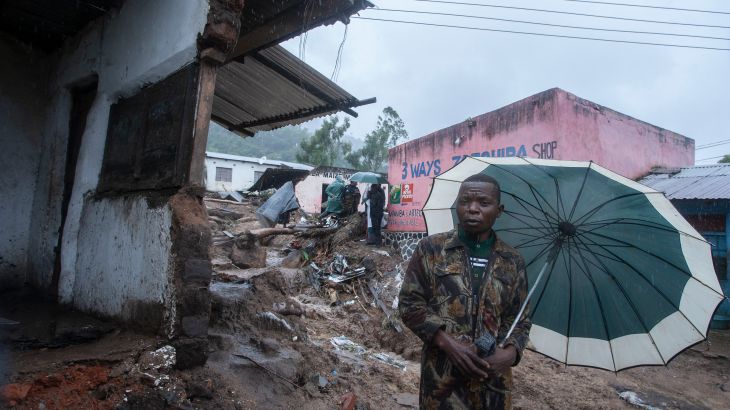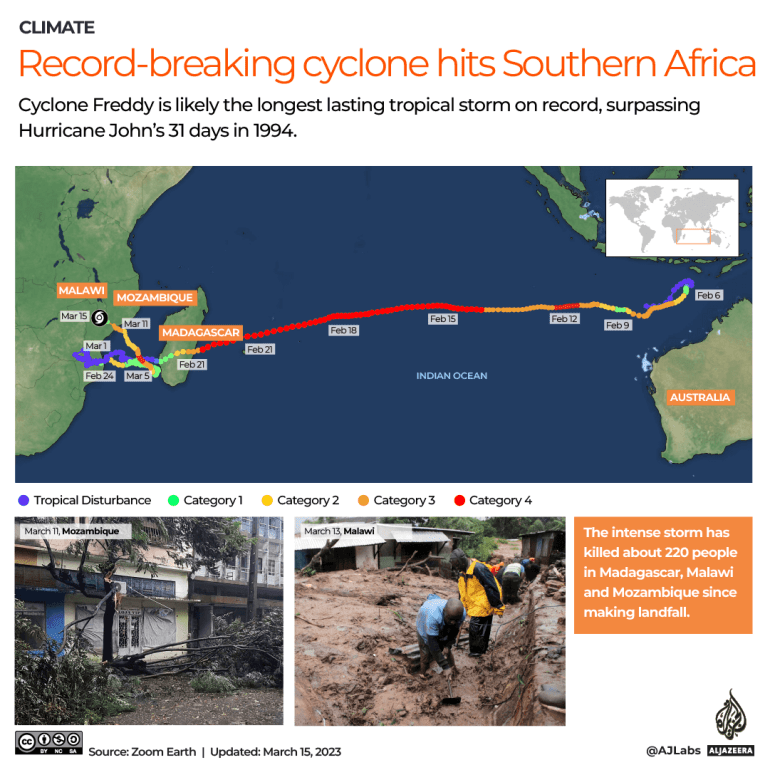More than 220 killed by record-breaking Cyclone Freddy
Vast majority of deaths occurred in Malawi from the highly unusual storm.

Tropical Cyclone Freddy hit the coast of Southern Africa for a second time over the weekend, bringing its total death toll to more than 220 people in Malawi, Mozambique and Madagascar.
The month-long storm has broken at least one record and could break two more, meteorologists say. As climate change causes warmer oceans, heat energy from the water’s surface is fuelling stronger storms.
Keep reading
list of 4 itemsDozens killed as Cyclone Freddy slams Malawi and Mozambique
Rains and high winds hit Mozambique as Cyclone Freddy nears
Mozambicans seek shelter as storm Freddy makes landfall
Here is what you need to know:
What happened to the victims?
By Tuesday afternoon, authorities counted 190 people dead in Malawi with hundreds more injured and missing. The official death toll in neighbouring Mozambique stood at 20.
Many of the dead were killed by mudslides in hilly Blantyre, Malawi’s second-biggest city. Torrential rain swept away thousands of homes and uprooted trees, leaving residents staring in disbelief at huge ravines in the roads and having to clamber across makeshift bridges as the rain continued.
“People have been missing for three days now,” said Al Jazeera’s Fahmida Miller, reporting from Blantyre in front of a group of men digging deep into mud to find bodies.
“People are saying it has been up to them to look out for those missing as there hasn’t been any rescue team in this area,” Miller said, adding that police showed up for a short time on Monday to then leave as it was unable to get through the mud.
Almost 60,000 people have been affected, of which about 19,000 were displaced from their homes, Malawi’s government said.
Rasmane Kabore, emergency coordinator for Doctors Without Borders in Blantyre, said the most pressing issue was the lack of clean water, which could cause a cholera outbreak.
Malawi last year reported cases of cholera after Cyclone Anna battered the south of the country causing extensive infrastructure damage and disruption of water and sanitation systems.
“We tried to increase our capacity in hospitals to accommodate more cholera patients, knowing that as the water of the city is cut off we may experience more cases,” Kabore told Al Jazeera.
“We decided to double our medical supplies and human resources to be ready in case we get more patients,” he said.
Unusual path
Freddy developed off the coast of Australia, crossed the entire south Indian Ocean, and travelled more than 8,000km (4,970 miles) to make landfall in Madagascar and Mozambique in late February.
It then looped back and hit the coast of Mozambique again two weeks later before moving inland to Malawi.
“No other tropical cyclones observed in this part of the world have taken such a path across the Indian Ocean in the past two decades,” said the US National Oceanic and Atmospheric Administration.
Only four storms have crossed the southern Indian Ocean from east to west with the last one in 2000, it said.

Highest cyclone energy
Freddy holds the record for most accumulated cyclone energy (ACE) – a measure based on a storm’s wind strength over its lifetime – of any storm in the southern hemisphere and possibly worldwide.
Freddy has generated about as much accumulated cyclone energy as an average full North Atlantic hurricane season, according to the World Meteorological Organization (WMO).
By last week it was in second place for the most accumulated cyclone energy of any storm since 1980, with the record held by Hurricane and Typhoon Ioke in 2006.
Some estimates show Freddy has since broken that record with 86 ACE compared with Ioke’s 85 ACE.
Record length
Freddy may have broken the record for the longest-lasting tropical cyclone on record, according to the WMO. The current record is held by a 31-day hurricane in 1994.
Freddy first developed on February 6 and made its second landfall on the coast of Mozambique on March 11 – 34 days later.
However, weather experts still have to look at several factors – such as the fact it weakened below tropical cyclone status at some points during that time – in order to determine whether it broke the record, said the WMO.
Most cycles of intensification
Freddy appears to have broken the world record for the most bouts of rapid intensification, defined as an increase in wind speed of 80km (35 miles) per hour in a period of 24 hours.
Freddy had seven separate cycles of rapid intensification, according to satellite estimates. The previous record was four, which was reached by several hurricanes.
The WMO will set up an expert committee to examine this record as well as the others, it said.
Climate change link?
Experts are cautious about whether Freddy can be specifically linked to climate change – a phenomenon measured over the long term rather than single events – but say it is consistent with predictions.
“Based on the IPCC report, this type of extreme tropical cyclone event is not surprising due to previous predictions that cyclones will become more intense,” said Lazenby, referring to the UN’s Intergovernmental Panel on Climate Change.
“More analysis would need to be done to deduce the reasoning behind its … longevity.”
Allison Wing, associate professor at Florida State University, said in general climate change is making cyclones stronger and wetter and increasing the risk of coastal flooding from storm surge because of sea-level rise.
Scientists have not detected any long-term trend in the number of cyclones, she said.
However, “there is evidence that tropical cyclones are getting more intense, and especially that the strongest storms are getting stronger,” said Wing.